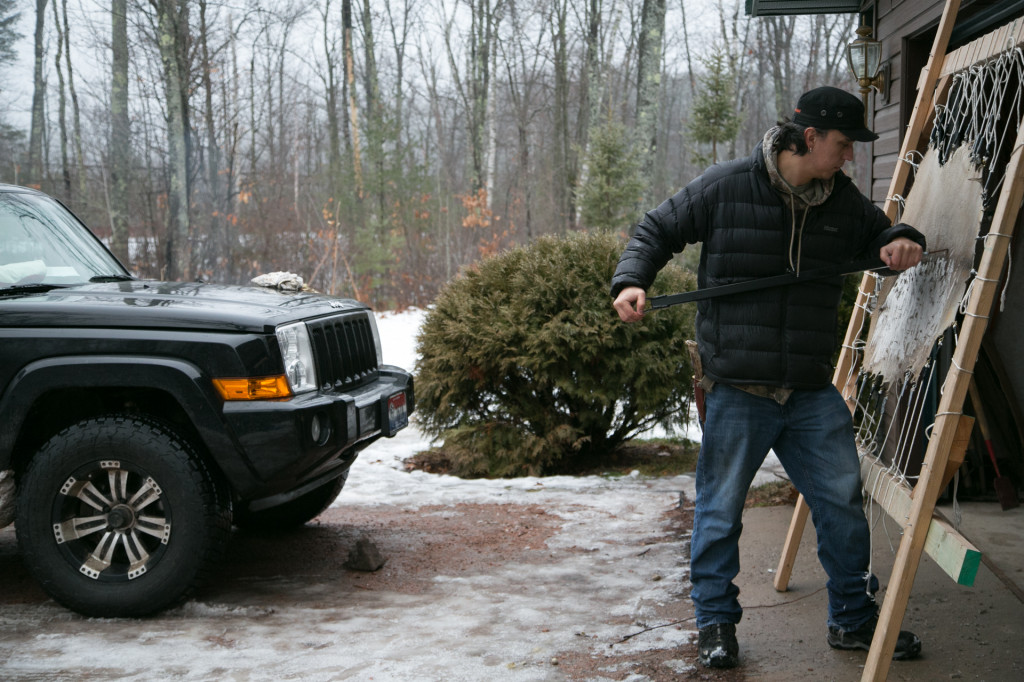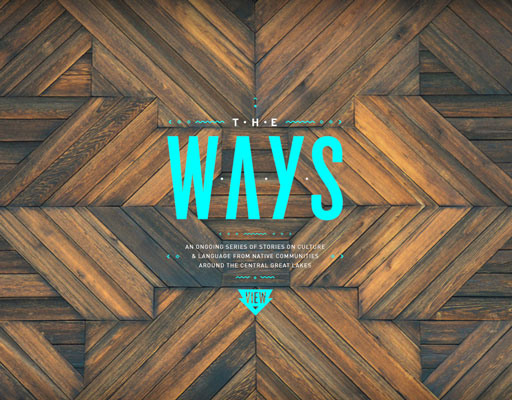Finn Ryan, a producer, educator and March 2011 MediaStorm Storytelling Workshop participant is a big believer in the importance of storytelling in education.
His 2010 project, Climate Wisconsin, which uses multimedia and interactives to explore local climate change impacts, received significant attention when it was published, including a regional Emmy Award for Outstanding Achievement for Informational/Instructional Programming.
His most recent project, The Ways, produced with Wisconsin Media Lab, features storytelling as a means to share contemporary Native culture and language from around the central Great Lakes.
I contacted Finn to hear about his experience creating The Ways and to take a closer look at contemporary ways to use storytelling in education. Below is a lightly edited version of our conversation.
An Interview with Finn Ryan
 You recently launched The Ways, an online storytelling publication about language and culture of Native communities in the central Great Lakes region. Why did you start the project?
You recently launched The Ways, an online storytelling publication about language and culture of Native communities in the central Great Lakes region. Why did you start the project?
The Ways started because we (Wisconsin Media Lab) identified a need for educational media about contemporary Native culture and language.
There is a law in Wisconsin that says all students and teachers must learn about American Indian history, culture, and sovereignty.
While there are a number of resources available on history and sovereignty in our region, there are very few sharing contemporary Native culture and language. The Ways is designed to address this specific need.
What stories have you published so far?
We’ve published four stories since launch. The first two stories, “Prayers in a Song” and “Living Language,” explore language revitalization, but approach it in very different ways. Despite the differences, both stories acknowledge and honor history while placing Native languages in a current context.
“Lake Superior Whitefish” and “Powwow Trail” do the same, but for cultural traditions. They show the connection to and build off the past through exploration of contemporary cultural ways.
How are the stories produced?
The stories in The Ways are produced by a small team with the support of an advisory board of Tribal members and educators. As the producer and director of the series, I work closely with our advisory board to select stories and subjects that show the diversity of culture and language among our region’s tribes.
The stories are published as they’re produced, which is a departure from how we released similar projects in the past, like Climate Wisconsin. We wanted to try this approach to build a community around the project.
Have you had any notable challenges in creating the site?
One of the main challenges with the project has been connecting with and establishing trust with Native communities. There is a history of media exploitation and prejudice against Native people and being a non-Native producer, this is an issue I’m continually trying to overcome.
With that said, our Native advisors are really supportive of the project and we now have supporters in many Native communities around the central Great Lakes. I feel like we are starting to gain momentum where enough Native communities know and trust the work we’re doing so finding stories and pre-production is becoming less challenging.
You participated in the March 2011 MediaStorm Storytelling Workshop. How did the experience impact the production of The Ways?
When I participated in the MediaStorm Storytelling Workshop, I had just finished production on Climate Wisconsin, a multimedia series on climate change impacts in Wisconsin.
While the project provided lots of experience, collaborating with other participants and the production staff at MediaStorm helped me better understand how to interview and portray subjects in an authentic way.
I have a background in culturally relevant education and this, coupled with the opportunity to discuss, challenge, and defend editing decisions at MediaStorm helped lay the groundwork for The Ways, where subject portrayal and authenticity is fundamental to the project’s success.
(The project Finn and his workshop team produced during the March 2011 workshop is The Amazing Amy.)
As an educator and a producer, where do you think multimedia storytelling fits into the educational landscape?
Multimedia storytelling plays an important role in education today. While there are instances where it can stand alone, the power I see in educational media is how it complements and supports inquiry.
For example, the video “Lake Superior Whitefish” engages students with a story about fishing while introducing the issue of Native treaty rights. For students with prior knowledge about fishing on Lake Superior, the story may offer a new perspective that promotes deeper inquiry about treaty rights.
For others, the story may simply be an introduction to commercial fishing. For all viewers though, the video is a starting place, a potential point of connection between their experience and contemporary Native culture.
From the point of engagement, the hope is that the video inspires students to want to know more. Maybe they begin researching treaty rights, maybe they determine how treaty rights affect the place where they live, or maybe they begin thinking about their own rights and how they have been challenged, lost, or protected.
This engagement, connection, and action is the power and potential of multimedia storytelling in education. Initial feedback from teachers and students for confirms that The Ways is supporting this potential and resulting in deep inquiry and reflection.
Do you have an example of the feedback you get on your projects?
Just last week a language teacher from the Eastern Band of Cherokee in North Carolina contacted us and described how she is using “Prayers in a Song” as a model for high school students in her community’s effort to revitalize their language.
After watching the video, her students are writing their own songs about Cherokee identity and language. They have 300 fluent speakers remaining, so you can see the necessity and power of storytelling in The Ways, and in education.
Do you have any advice for producers, storytellers or educators trying to do something similar?
I know research takes time, but the more I produce, the more I feel like I can never do enough research on a story and subject, specifically when I’m producing an educational story.
For each story I studied the context of the cultural activity or language in relation to the subject’s experience. This research is supported by the background text written by tribal members and partners. The hope is that this provides an authentic context for each story.
What stories are you currently working on?
As I said earlier, the first two stories, “Living Language” and “Prayers in a Song” focus on Menominee and Ojibwe language revitalization. Our third and fourth stories, “Lake Superior Whitefish” and “Powwow Trail” focus on culture.
We’re currently working on stories looking at Ho-Chunk language revitalization, a Mohican clan mother, and deer hunting in the Lac du Flambeau community.
Now that you’ve published your first four projects, what does the future of The Ways look like?
The Ways is currently funded for the production of nine stories, which we will release monthly as they’re completed. We’re excited by some of the upcoming stories featuring community healing, deer hunting, and youth athletics in Native communities.

Once the nine stories are online, we will focus our full attention on promotion and helping educators and students integrate The Ways into their teaching and learning. We will also look for new partnerships that could support the continuation of the project.
The more stories we produce and share, the more we come across that could expand the scope and strengthen the project.
The Ways is public educational media funded by the State of Wisconsin.
About Finn Ryan
Finn Ryan is a producer and educator based in Madison, Wisconsin. His current project, The Ways, features stories on language and culture from Native communities around the central Great Lakes. He produced and directed the regional Emmy Award winning Climate Wisconsin, which features multimedia stories and interactive data exploring local climate change impacts.
As a producer for Wisconsin Media Lab, a state public media agency, he has also collaborated with Wisconsin Public Radio and Wisconsin Public Television to produce environmental science stories for QUEST, a national public media project headed by KQED.
Finn has worked as a high school special education teacher and co-founded an outdoor education program. He holds a bachelor’s degree in special education and English, and a master’s in curriculum and instruction, all from the University of Wisconsin, Madison.
Finn participated in the March 2011 MediaStorm Storytelling Workshop, where participants work alongside MediaStorm staff to create an intimate, character-driven documentary in just one week. Learn more about upcoming MediaStorm workshops and online training at mediastorm.com/train.


